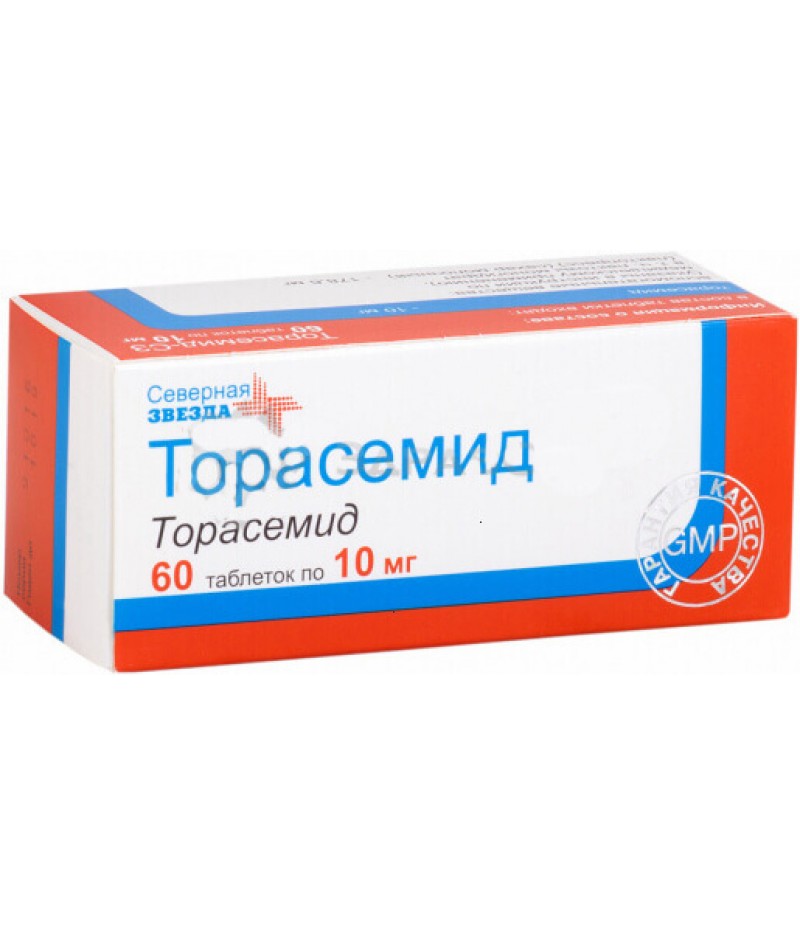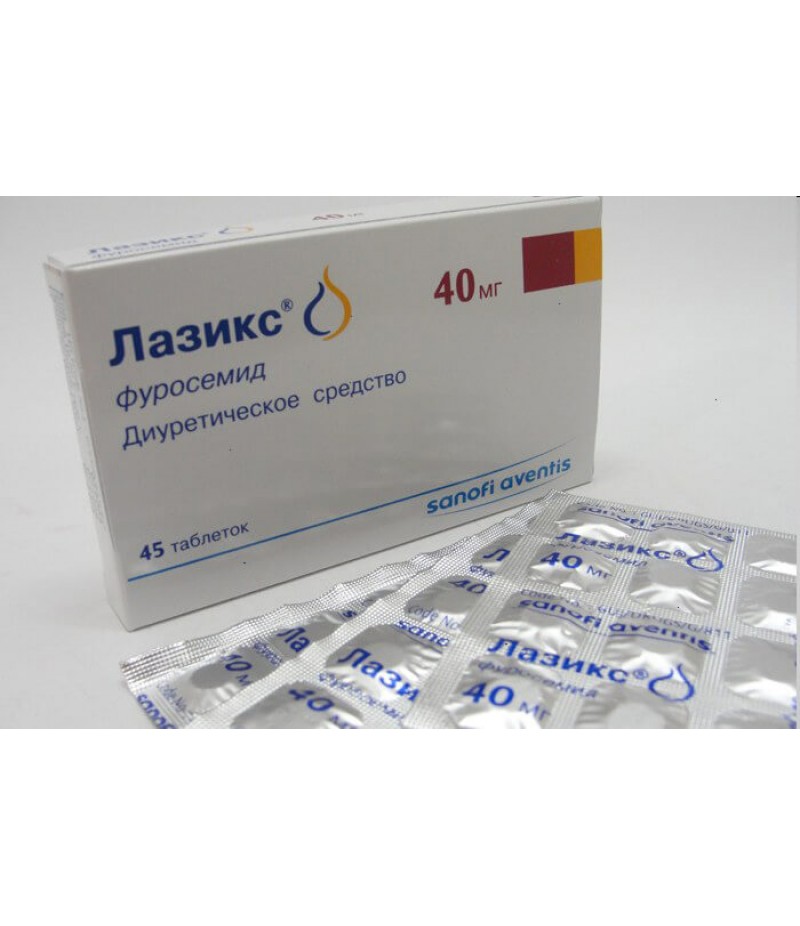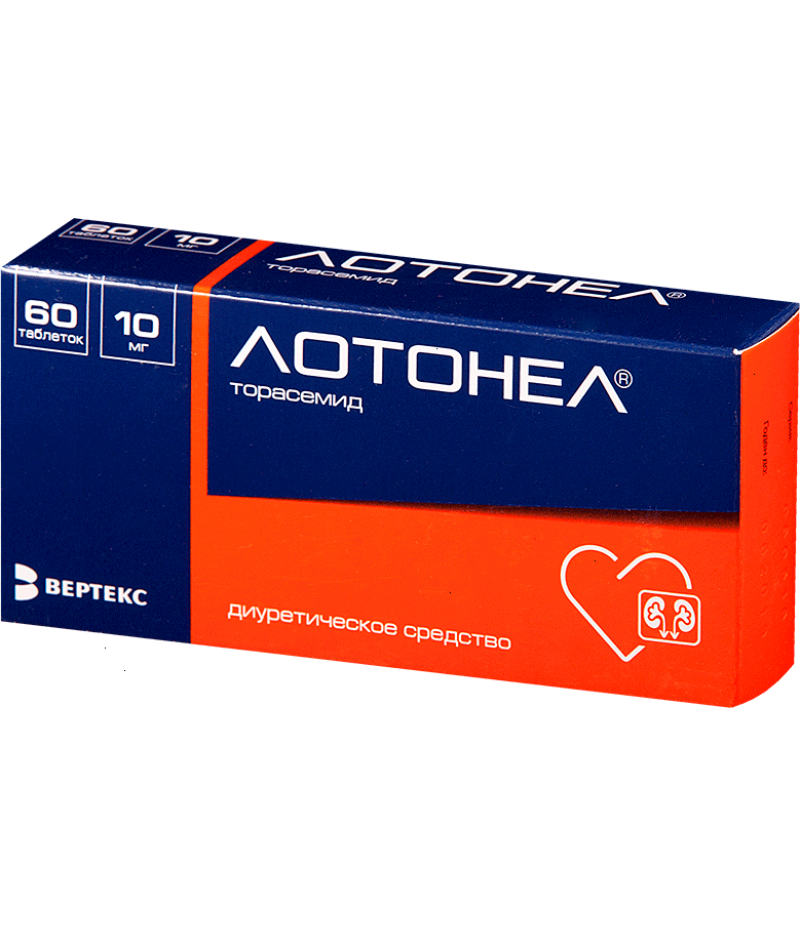Torasemide tabs 10mg #60
- $12.14
- 3 or more $11.99
- Availability:In Stock
Instruction for TorasemideReed more and buy Torasemide on this pageCompositionOne tablet of the preparation may include 2.5 / 5/10/20/50/100 or 200 mg torasemide as an active ingredient.Additional ingredients of tablets of 2.5 / 5..
Tags: tabs
Instruction for Torasemide
Reed more and buy Torasemide on this page
Composition
One tablet of the preparation may include 2.5 / 5/10/20/50/100 or 200 mg torasemide as an active ingredient.
Additional ingredients of tablets of 2.5 / 5/10 and 20 mg: corn starch, lactose, colloidal silicon dioxide, magnesium stearate, microcrystalline cellulose.
Additional ingredients of tablets of 50; 100 and 200 mg: colloidal silicon dioxide, magnesium stearate, microcrystalline cellulose, mannitol (E 421), crospovidone, copolyvidone, hydrogenated castor oil.
Form of issue
Torasemide Sandoz is available in the form of tablets of 20 or 100 pieces in one package.
pharmachologic effect
Diuretic (diuretic).
Pharmacodynamics and pharmacokinetics
Torasemide Sandoz refers to a group of diuretics called loop diuretics. Small doses of torasemide are used to treat arterial hypertension, both in monotherapy and in combination with other antihypertensive drugs, where torasemide exhibits mild saluretic and diuretic effects. Higher doses of the drug have enhanced diuretic effects depending on the dose used. The maximum diuretic activity of Torasemide Sandoz is observed after 2-3 hours after oral (internal) administration.
Internal reception of torasemide results in rapid absorption and almost complete absorption. Plasma Cmax is observed after 60-120 minutes, systemic bioavailability at the level of 80-90%. The connection with plasma proteins is more than 99%, with a volume of distribution equal to 16 liters.
Metabolism proceeds by hydroxylation and oxidation with the release of 3 metabolites: M1, M3 and M5, where M1 and M3 are active (about 10% of the pharmacological effects of the drug).
In healthy people, the final T1 torasemide, as well as its metabolites, is 3-4 hours. Renal clearance is close to 10 ml / min with a total clearance of 40 ml / min.
About 80% of the dose, the most unchanged torasemide (24%) and its metabolic products M1 (12%), M3 (3%) and M5 (41%) are released.
With kidney failure, T1 metabolites of the drug (M3 and M5) increases, although T1 torasemide remains unchanged. Hemofiltration and hemodialysis are practically ineffective.
With heart failure and liver pathologies T1 metabolite M5 and the active ingredient somewhat elongated, but without the proven cumulation of the drug.
Indications for use
For tablets with a mass content of torasemide 2.5 and 5 mg: - therapy of essential hypertension.
For tablets with a mass content of torasemide 5; 10 and 20 mg: - prevention or reduction of edema in patients suffering from heart failure.
For tablets with a mass content of torasemide 50; 100 and 200 mg: - prevention or reduction of edema, as well as increased blood pressure for renal insufficiency (CRF) of a serious nature with a CC less than 20 ml / min, provided there is residual diuresis greater than 200 ml per day, including patients on hemodialysis.
Contraindications
high sensitivity to torasemide, or additional ingredients of the drug;
hepatic precoma or coma;
kidney failure with anuria;
arrhythmia;
arterial hypotension;
hyponatremia;
age up to 18 years;
hypovolemia;
periods of breastfeeding and pregnancy;
hypokalemia;
serious problems in the process of urination, for example, because of prostate adenoma.
Side effects
Hepatobiliary system:
increase in the blood plasma content of individual hepatic enzymes, in particular γ-glutamyl-transpeptidase.
The cardiovascular system:
cerebral and cardiac ischemia with a risk of developing heart rhythm disorders, angina pectoris, myocardial infarction;
arterial hypotension;
thromboses;
fainting states.
Blood system and lymphatic system:
a decrease in the number of platelets, white blood cells, erythrocytes or their aggregate.
Gastrointestinal organs:
loss of appetite;
pain in the stomach;
nausea;
flatulence;
vomiting;
pancreatitis;
diarrhea or constipation.
Skin:
various allergic manifestations, for example exanthema, pruritus, photosensitivity, rash (there is evidence of the development of severe skin reactions).
Urinary system:
increase in plasma levels of urea and creatinine;
urge to urinate;
In patients suffering from disorders of the process of urination, for example, with prostate adenoma, bladder enlargement and urinary retention were observed.
Metabolism:
metabolic alkalosis;
muscle spasms (especially at the beginning of therapy);
hypokalemia in patients with chronic liver dysfunction, with diarrhea or vomiting, concomitant low-potassium diet, excessive intake of laxatives;
increase in blood plasma glucose, uric acid and lipids (ChS, TG);
disturbances of electrolyte and water balance of different severity, depending on the duration of therapy and the dosage of the drug;
arterial hypotension, asthenia, headaches, drowsiness due to increased urination, which leads to significant loss of fluid, especially at the beginning of therapy and in elderly patients.
Are common:
general weakness (especially at the beginning of therapy);
headache;
dry mouth;
confusion of consciousness;
visual impairment;
dizziness;
noise in ears;
increased fatigue;
loss of hearing;
paresthesia of the extremities.
Instructions for use Torasemide
Please reed this instruction before buy Torasemide.
Instructions for use Torasemide Sandoz recommends the oral (internal) intake of whole tablets in the morning, washed down with water.
Duration of admission depends on the nature of the disease state (with heart failure, therapy is continued until the edema disappears).
With arterial hypertension, the initial dose of torasemide for adults is 2.5 mg for 24 hours. In the case of an insufficient decrease in blood pressure after a 2-month treatment, an increase in the daily dose to 5 mg is possible. The maximum effectiveness, as a rule, is observed after 3 months of therapy. Doses of the drug above 5 mg do not give an additional antihypertensive effect.
To prevent or reduce edema, it is recommended to begin treatment with torasemide at a daily dose of 5 mg, which if necessary is doubled (10 mg). With severe swelling, a gradual increase in the daily dose to 20 mg is possible.
Cirrhosis of the liver requires a total initial daily dose of 5 to 10 mg, with a parallel intake of antagonist drugs, aldosterone, or diuretics that promote retention in the body of potassium. In the absence of a sufficient diuretic effect, the dose is doubled (from 10 to 20 mg).
With CRF, the dosage of Torasemide Sandoz is determined individually, depending on the degree of the disease state. Usually the initial daily dose of the drug is 20 mg and, if necessary, gradually increases up to a dose of 200 mg in 24 hours, which is the maximum. This dose is prescribed only in cases of severe renal dysfunction with CC less than 20 ml / min, as well as during hemodialysis, in the case of diuresis, which is not less than 200 ml per day.
Overdose
The typical symptoms of an overdose of torasemide are unknown. Possible forced diuresis with excessive loss of electrolytes and fluid, drowsiness, arterial hypotension, confusion, digestive tract disorders, cardiovascular failure.
There is no specific antidote. Depending on the manifestations of an overdose, a decrease in the dose taken or a complete withdrawal of the drug is indicated. It is recommended to carry out measures to recover losses in the water-electrolyte balance. Hemodialysis is ineffective.
When hypovolemia, replace the volume of fluid lost. With hypokalemia, prescribe potassium preparations. With the manifestation of cardiovascular failure, the patient is given a sitting position and symptomatically treated.
At the first occurrence of skin reactions (for example, reddening of the skin or urticaria), headache, agitation, increased sweating, cyanosis, nausea, it is recommended to conduct vein catheterization. The patient is given a horizontal position, provides a free flow of air, and oxygen is prescribed. If necessary, enter Epinephrine, glucocorticoids and solutions that compensate for fluid loss.
Interaction
Parallel administration of torasemide and cardiac glycosides may increase the sensitivity of the myocardium to these drugs, due to the observed deficiency of magnesium or potassium.
Torasemide enhances the effects of other antihypertensive agents, including ACE inhibitors, which can cause severe hypotension. To prevent the development of hypotension, the dose of one or another drug should be adjusted.
When combined with laxatives, glucocorticoids and mineralocorticoids, the risk of potassium deficiency increases.
Torasemide reduces the effectiveness of antidiabetic drugs and weakens the vasoconstrictive effect of norepinephrine and epinephrine.
High doses of torasemide may potentiate the ototoxic and nephrotoxic effects of antibiotics of the aminoglycoside series (Kanamycin, tobramycin, Gentamicin), nephrotoxic effect of cephalosporins and toxic effects of platinum preparations.
Torasemide increases the effectiveness of curare-like muscle relaxants and Teofillin.
NSAIDs and Probenecid weaken the hypotensive and diuretic effect of torasemide.
The combined use of lithium and torasemide preparations can lead to an increase in the lithium content in the blood, which will enhance its neurotoxicity and cardiotoxicity.
Torasemide enhances the toxic effects of salicylates (in high doses) on the central nervous system.
Simultaneous reception of Kolestyramin can reduce the absorption of torasemide, which leads to a weakening of its action.
Storage conditions
Torasemide Sandoz, in its original packaging, should be stored at a temperature of up to 25 ° C.
Shelf life - 36 months.
special instructions
Prior to the appointment of therapy with the use of Torasemide Sandoz, the concentration of sodium and potassium, as well as the volume of circulating blood should be normalized.
When carrying out long-term treatment, it is recommended to conduct regular studies of electrolyte balance (especially in patients who simultaneously use glucocorticoids, glycosides of digitalis, laxatives, mineralocorticosteroids), glucose, creatinine, uric acid and blood lipids.
Patients with diabetes should observe the metabolism of carbohydrates.
Patients with a tendency to develop gout and hyperuricemia require special attention from the physician.
Do not recommend the use of torasemide in patients with pathological changes in the acid-base balance; altered blood picture (anemia, thrombocytopenia, etc.) in patients without kidney failure; in combination with lithium, cephalosporins and aminoglycosides; children; with renal pathologies due to the use of nephrotoxic substances; in old age.
Torasemide Sandoz requires special caution in appointing patients with liver pathologies that are accompanied by ascites and cirrhosis, as abrupt fluctuations in water-electrolyte equilibrium can cause hepatic coma. In this regard, treatment diuretic patients of this group should be conducted in the hospital. To prevent manifestations of metabolic acidosis and hypokalemia, the parallel administration of aldosterone antagonists or potassium-sparing drugs is necessary.
Sometimes after taking torasemide, ototoxicity phenomena (hearing loss, tinnitus), reversible and without a proven cause-effect relationship, were observed.
Therapy with diuretics requires constant monitoring of electrolyte balance, extrarenal azotemia, hypovolemia and other disorders of which symptoms may be: dry mouth, thirst, lethargy, weakness, drowsiness, tachycardia, muscle cramps or pain, agitation, myasthenia gravis, oliguria, hypotension, nausea, passing into vomiting. High diuresis can lead to dehydration of the body and a decrease in the amount of circulating blood, embolism and thrombosis in the vessels, especially in elderly patients.
With water-electrolyte disorders, it is necessary to interrupt therapy, with the possibility of its continuation in lower doses after elimination of negative symptoms.
Regular monitoring of plasma levels of potassium and other electrolytes should be performed.
Tablets of the drug from 2.5 mg to 20 mg include lactose, which should be taken into account when prescribing to patients with intolerance to sugars.
Tablets from 50 mg to 200 mg contain hydrogenated castor oil, which can lead to gastrointestinal and diarrhea disorders.
Children
Torasemide Sandoz is contraindicated for prescription at the age of 18 years.
During pregnancy (and lactation)
It is not recommended to take Torasemide Sandoz during periods of breastfeeding and pregnancy (lack of experience of use).
Reviews of Torasemide Sandoz
The doctors' comments about Torasemide Sandoz, in comparison with its main analogue - Furosemide, speak about its more pronounced efficacy and safety of use. Torasemide has greater bioavailability and duration of action, less influence on water-electrolyte balance, concentration of lipids, potassium and other elements of blood, can be used for renal and hepatic insufficiency, it shows fewer side effects.



